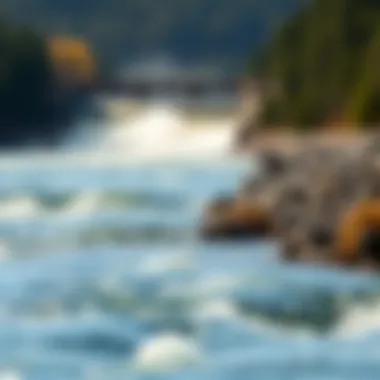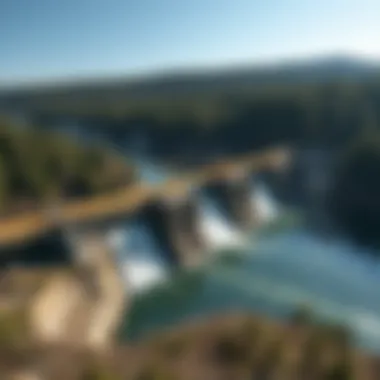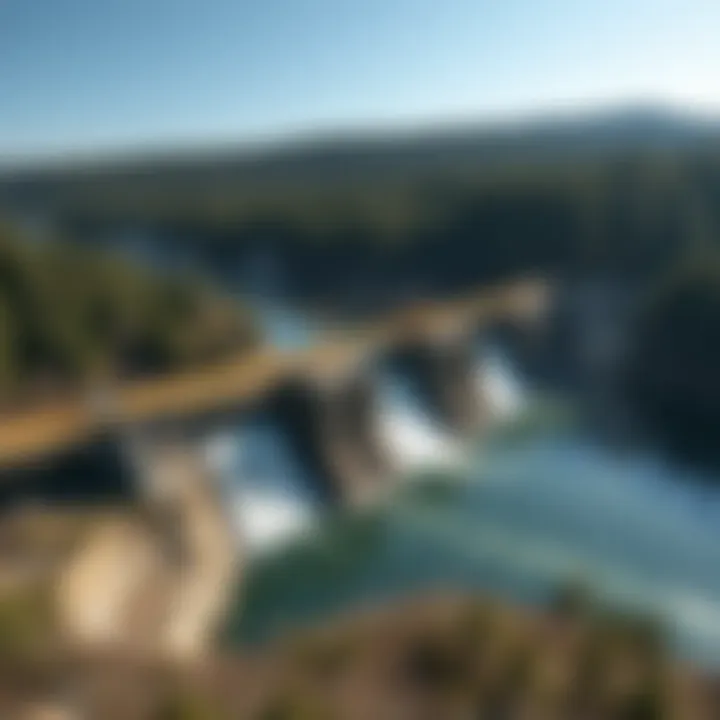Environmental Impact of Dams on Ecosystems


Intro
The construction of dams has always sparked transformations in the fabric of ecosystems, and the choices made in these areas can pivot towards coexistence or conflict. With various water bodies at risk due to urban expansion and climate change, understanding the environmental effects of these artificial barriers can prove essential in navigating the present and future landscape of ecological management. As human needs for energy and water escalate, so do the consequences of damming rivers, which range from altering habitats to impacting local communities.
This discussion aims to shine a light on the interconnectedness of environmental health and human advancement through dam projects, highlighting both the positive and negative implications. By delving into specific areas, including Forest Ecology and Biodiversity, we can begin to grasp the ripple effect these structures have on raw nature and the intricate dances of life that play out in woodlands and waters alike.
Forest Ecology and Biodiversity
Importance of Forest Ecosystems
Forest ecosystems serve as crucial guardians of the planet, playing multiple roles in supporting biodiversity and maintaining ecological balance. These lush landscapes provide essential resources such as oxygen, food, and habitat for countless species. More than just a pretty scene, forests act like sponges, absorbing rainfall and regulating water cycles. When dams are constructed, they can convert a vibrant ecosystem into a lifeless expanse.
For instance, the building of the Trois Gorges Dam in China has caused significant shifts in the local ecology, displacing a myriad of flora and fauna that once flourished in what became submerged land. As trees are uprooted and habitats dissolved under water, the intricate relationships between species can unravel, leading to reduced biodiversity.
Flora and Fauna in Woodlands
In forests, diverse plant species provide food and shelter to a range of animals. The interaction between these organisms creates a tapestry of life that thrives in equilibrium.
Dams disrupt these balances, often causing species that depend on specific habitats to struggle or face extinction. For example, migratory fish like salmon, known for their remarkable life cycle, are directly affected by damming rivers, as they can no longer traverse waterways to reach their spawning grounds. The blockage interrupts not just their reproduction but the natural flow of nutrients that supports the broader food web.
Moreover, even terrestrial animals can feel the pinch. Changes in water availability and distribution affect everything from herbivores that graze on specific plants to the predators that rely on them for sustenance. This domino effect alters the very fabric of the ecosystem and can trigger a chain reaction that may be complicated to reverse.
"The intricate ties in ecosystems are as delicate as a spider’s web; a single change can send ripples through the entire structure, creating consequences far-reaching and unexpected."
Understanding these interactions emphasizes the significance of maintaining biodiversity within forests, as every species plays a role—no matter how small. Preservation of these natural habitats is not merely beneficial; it is crucial for sustaining environmental health and resilience.
In the subsequent sections, we will uncover the broader implications of dams on sustainable forestry practices and the essential role local communities play in stewardship. Addressing community involvement can bridge the gap between land, water, and human influence, aiding in the pursuit of equilibrium in this complex relationship.
Preface to Dams and Their Purposes
Dams are critical structures in our modern landscape, serving multiple purposes that intertwine with human needs and environmental considerations. They are not just concrete barriers blocking rivers; they are intricate systems that influence water management, ecology, and even social dynamics. This section provides an overview of why understanding dams is essential for both forestry professionals and academics alike, as we navigate the complex interplay between development and environmental stewardship.
Definition and Function of Dams
In simplest terms, a dam is a barrier constructed to hold back water, creating a reservoir or redirecting river flow. Dams serve several key functions, including:
- Water Supply: Many municipalities rely on dams to store fresh water, ensuring a consistent supply for consumption, agriculture, and industry.
- Flood Control: By regulating river flow, dams help mitigate floods, protecting surrounding lands and cities from potential destruction.
- Hydropower Generation: A significant contribution to renewable energy, dams convert potential energy from stored water into electricity, offering a cleaner alternative to fossil fuels.
- Recreation: Reservoirs created by dams also provide spaces for recreation such as boating, fishing, and swimming, enhancing community wellbeing.
These functions illustrate the multifaceted nature of dams. However, as we will see in further sections, they also come with complications that merit careful examination.
Historical Context of Dam Construction
The story of dams stretches back thousands of years. Ancient civilizations, like the Romans and Egyptians, constructed early versions of dams for irrigation and flood prevention. Over time, as population centers grew, so did the need for structured water management. Understanding the historical significance of dam construction unveils a journey of technological advancement, responding to the evolving needs of society while also posing questions about ecological impacts.
In the 20th century, the global push for infrastructure led to a surge in dam construction. The Hoover Dam, built in the 1930s, epitomizes this trend and showcases capabilities in flood control and energy generation. Yet, as history teaches, the rush to build often overlooks the subtleties of environmental ramifications, which are now coming to light in contemporary discussions.
Types of Dams and Their Applications
Different contexts call for different types of dams, each with unique characteristics and uses that influence their environmental check-ins. Understanding these types is paramount for comprehending their respective impacts.
Gravity Dams
Gravity dams owe their effectiveness to sheer weight, using the force of gravity to hold back water. Constructed primarily from concrete or masonry, these structures are effective for high-pressure situations. The typical advantage of gravity dams is their ability to be built in various terrains, providing flexibility in usage. However, their massiveness can create significant environmental effects, such as altering local water temperatures and flow rates, which can ripple through ecosystems dependent on natural patterns.
Arch Dams
Arch dams are known for their elegant curvature, allowing them to deflect water pressure into the canyon walls. Their lightweight design offers the ability to utilize less material than gravity dams, making them attractive in terms of both cost and environmental footprint. Despite their advantages, these dams require specific geological conditions to be effective; their construction can impact local habitats, particularly during the buildup of reservoirs.
Embankment Dams


Built from earth materials like soil or rock, embankment dams are less expensive compared to their concrete counterparts. They are often used in locations where the natural topography can support a large dam without extensive construction. These types of dams can provide immense water storage capacity, but they also have disadvantages, mainly concerning erosion and sediment displacement in rivers. Too often, such alterations can lead to downstream ecological changes, threatening fish populations and other aquatic life.
In closing, examining these various dam types reveals not just engineering marvels but also points to the necessity of addressing their environmental ramifications. Recognizing how these structures affect our ecologies enables us to navigate their complexities, paving the path for sustainable management practices.
Ecosystem Disruption
Alteration of Natural Water Flow
One of the most immediate and profound effects of dam construction is the alteration of natural water flow. Rivers, which have carved their paths through landscapes over millennia, face upheaval once a dam is introduced. Water levels can rise dramatically behind a dam, creating reservoirs that change the physical characteristics of the river. This altered flow regime can disrupt sediment transport, affecting land formations downstream and altering habitats for countless organisms.
When the natural flow is significantly altered, organisms that depend on specific flow characteristics may struggle, leading to shifts in local populations. For instance, many fish species rely on natural cues related to flow patterns for spawning. Disruption in these patterns can affect reproduction cycles, ultimately leading to declines in fish stocks and impacting local fisheries and economies relying on them.
Impact on Aquatic Habitats
The structural changes caused by dams reverberate throughout aquatic habitats. Beyond merely altering water flow, dams affect the physical and chemical attributes of water, which in turn influences the biota within these ecosystems. The two aspects we delve into—Effects on Fish Populations and Changes to Invertebrate Communities—highlight specific impacts that resonate throughout aquatic ecosystems.
Effects on Fish Populations
Fish populations are among the most visibly impacted when a dam is erected. The blockage created by a dam effectively creates a barrier to movement for many aquatic species, especially migratory fish like salmon. When access to spawning grounds is cut off, the consequences can be detrimental.
- Key Characteristic: One notable facet is the reduction in genetic diversity as fish populations become isolated, adversely affecting their resilience.
- Relevance to the Topic: Understanding these effects is crucial for effective management and conservation efforts. By recognizing how dams interfere with fish movements and life cycles, we can identify strategies for mitigation, such as developing fish ladders.
- Unique Feature: The unique struggle these populations face not only comprises habitat fragmentation but also their dependency on the ecological conditions that exist in both upstream and downstream environments. The lack of a suitable migratory passage can lead to long-term decline in populations, which may never fully recover unless ecological restoration efforts are employed.
Changes to Invertebrate Communities
Invertebrate communities often suffer from direct and indirect effects of dam alterations. The chemical composition and physical characteristics of the water can shift dramatically, influencing which species thrive.
- Key Characteristic: Changes in water temperature, reservoir depths, and sediment composition can lead to the decline of specific sensitive invertebrates that play vital ecological roles, such as pollinators and decomposers.
- Relevance to the Topic: The health of invertebrate communities can offer insights into the broader health of aquatic ecosystems. A decline in these populations can indicate poor water quality or habitat degradation, which is crucial for fish populations and overall ecosystem vitality.
- Unique Feature: The diversity of these communities means that when one species suffers, it can trigger a chain reaction affecting other species, making this an important area of study concerning overall ecosystem disruption caused by dams.
Terrestrial Ecosystem Changes
Dams do not only alter aquatic environments; terrestrial ecosystems also face substantial shifts. When the water level increases behind a dam, forests may transform into wetlands, or vice versa, leading to changes in land cover, plant species diversity, and animal habitats. The introduction of stagnant water can foster conditions conducive to the growth of certain species, while others may face decline.
Moreover, the construction of access roads and associated infrastructure can fragment habitats and disrupt local wildlife. Species that once roamed freely may find their pathways blocked, leading to increased competition for the remaining space and resources. This fragmentation does not just reduce biodiversity; it can lead to shifts in predator-prey dynamics and alter community structures, with further implications for species management and conservation efforts.
"Dams, while serving human needs, can unwittingly become agents of significant ecological disturbance. Understanding their far-reaching implications is essential for maintaining a healthy balance within our ecosystems."
In sum, the disruption of ecosystems caused by dams is a multifaceted issue. It involves a complex interplay between water flow alterations, impacts on aquatic habitats such as changes to fish populations and invertebrate communities, along with terrestrial shifts. It invites ongoing dialogue about mitigation strategies that seek to harmonize human development with ecological well-being. For further reading, resources are available at Britannica, Wikipedia, and various ecological databases from *.gov and *.edu domains.
Water Quality Considerations
The impact of dams on water quality can’t be overstated. When we think of rivers, we often imagine clear, flowing water, teeming with life. However, the construction of dams disrupts these natural systems and can lead to significant changes in water quality. Understanding these considerations is vital when assessing the overall effects of dams on the environment.
Chemical Alterations Due to Reservoirs
One of the fundamental shifts in water quality post-dam creation is the chemical alterations occurring within the newly formed reservoirs. As a dam creates a large body of water, it changes the flow dynamics, which can lead to increased sedimentation. This sediment can introduce nutrients, such as phosphorus and nitrogen, which can unleash a variety of repercussions.
- Altered Composition: Reservoirs may become stratified, which alters how oxygen levels are distributed. The lower layers of water can become hypoxic, a condition that is detrimental to aquatic life. Fish and other organisms depend on specific chemical balances; a shift can trigger die-offs.
- Pollutant Concentration: Chemicals from agricultural runoff can accumulate in still waters more significantly than in flowing water. With diminished flow, there is less dilution, thus elevating concentrations of harmful substances like fertilizers or heavy metals.
This isn’t just a minor concern; it’s a fundamental shift in the ecosystem balance of aquatic habitats.
Temperature Variations
Temperature is another critical aspect of water quality that can dramatically shift due to dam-related alterations. The water in a reservoir heats up more than in a flowing river, impacting various physical and biological factors. This increase in temperature can have mixed consequences:
- Stratification Effects: Warmer temperatures can lead to stratification, much like chemical alterations, limiting the movement of colder, oxygen-rich water. This stratification often results in uneven distributions of thermal layers and can create dead zones.
- Impact on Species: The change in temperature can affect the native aquatic species, too. Species that thrive in cooler waters may find themselves struggling. Fish, for instance, have optimal temperature ranges; exceeding these can stress populations.
Understanding these temperature variations is essential for maintaining healthy aquatic ecosystems.
Eutrophication and Its Consequences


One of the more alarming results of dam construction is the phenomenon known as eutrophication. This process is fueled by nutrient overload, primarily phosphorus and nitrogen, leading to rampant growth of algae in reservoirs. This can spiral out of control and lead to severe environmental consequences:
- Algal Blooms: These blooms can block sunlight from reaching deeper water, disrupting photosynthesis in aquatic plants and leading to oxygen depletion.
- Toxins Release: Some algal species produce toxins that are harmful not only to aquatic life but also to humans and wildlife. The result can cause significant public health risks, especially where water is used for recreation, drinking, or irrigation.
"Eutrophication transforms clear lakes into green soup, demonstrating how nutrient pollution can rapidly alter ecosystems."
References for further reading include:
- Environmental Protection Agency
- National Oceanic and Atmospheric Administration
- United States Geological Survey
Biodiversity and Species Migration
Biodiversity is the backbone of ecological resilience, encompassing the variety of life forms within an ecosystem. In the context of dam construction, understanding species migration is critical, especially given how these structures disrupt established ecosystems. Not only do dams create physical barriers in rivers, but they also alter the surrounding environment, leading to complex challenges for both aquatic and terrestrial organisms.
Obstacles to Fish Migration
One of the primary concerns regarding dams is their potential to obstruct fish migration. Many fish species, notably salmon, depend on upstream and downstream movements to complete their life cycles. Dams, when placed along migratory routes, serve as formidable barriers that can severely impact fish populations.
- Physical barriers prevent adult fish from spawning in their traditional upstream habitats.
- Young fish may suffer increased mortality rates as they attempt to navigate through altered water flows.
- Inevitably, these challenges can lead to decreased genetic diversity among fish populations, making them more vulnerable to disease.
“Where there’s a will, there’s a way,” but for many fish, the will alone isn’t enough when faced with concrete walls and altered waterways.
Changes in Wildlife Movement Patterns
Beyond fish, the construction of dams also affects the movement patterns of terrestrial wildlife. Mammals, birds, and even some invertebrates can find their migration routes disrupted. This can have significant ramifications on reproductive success and food availability. Consider the following points:
- Changes in habitat availability due to altered floodplain dynamics can force wildlife to adapt to new areas, often leading to competition for resources.
- Animals that once traveled through areas now submerged may find their traditional routes blocked, leading to isolated populations.
- Increased human activity around dam sites often leads to habitat degradation, further complicating wildlife movement.
Endangered Species and Habitat Fragmentation
The consequences of dam constructions can be dire for endangered species. Habitat fragmentation caused by dams leads to isolated populations that may struggle to survive. Some key considerations include:
- Fragmented habitats can hinder genetic exchange, ultimately decreasing the resilience of species to environmental pressures.
- Species that rely on large territories may find their natural range compressed, leading to starvation and increased vulnerability to extinction.
- Conservation efforts may also become more challenging as resources are needed to monitor and maintain fragmented habitats.
In summary, while dams can bring about substantial benefits in terms of human development and water management, the detrimental effects on biodiversity and species migration cannot be overlooked. The loss of connectivity between habitats can devastate populations, leading to long-term ecological consequences.
For further reading on the impact of dams on ecosystems, you might explore Wikipedia or Britannica.
Societal Impacts of Dam Constructions
Dams are monumental structures that serve various utilitarian purposes, yet their construction brings about several societal impacts that deserve careful examination. These impacts ripple through communities, affecting not only the immediate landscape but the very fabric of social environments. Understanding these consequences is not just an academic exercise; it provides critical context for balancing human needs against environmental health. In this section, we will dive into the nuances of community displacement, economic shifts, and the interplay of cultural heritage with land use changes. Each of these elements plays a significant role in how society adapts to the presence of a dam and its associated infrastructure.
Displacement of Communities
When a new dam is constructed, it often requires the flooding of lands that have been home to communities for generations. This forced relocation, whether voluntary or mandatory, can lead to significant social upheaval.
The displacement can create a domino effect - breaking apart families, uprooting cultural practices, and dismantling tight-knit communities. For instance, the construction of the Three Gorges Dam in China led to the displacement of over a million residents. Not just a statistic, each of these individuals faced the challenge of starting anew in unfamiliar lands. Often, the new areas lack the same natural resources or social networks, making resettlement even more complex.
The psychological wealth that these communities have accumulated over the years cannot be quantified easily. It isn’t merely about losing a house; it’s about losing a sense of belonging and disrupting familial legacy.
Economic Changes and Opportunities
On the flip side of disruption lies economic change. While the initial dam construction can drain local economies in the short run due to displacement, the long-term effects can sometimes open new doors. Dams often provide significant opportunities for job creation, from the construction phase through to maintenance and operation.
Additionally, these structures, particularly large-scale hydroelectric dams, can generate substantial power. Regions once considered underdeveloped may experience an influx of investment, making them magnets for businesses looking to capitalize on newly available energy resources. This can lead to:
- Increased job opportunities in construction and maintenance.
- Boosting local industries due to enhanced electrical supply.
- Attracting tourism, if managed well.
Yet, it’s essential to approach these opportunities with caution. It’s not uncommon for the economic benefits to be unevenly distributed. Often larger corporations may reap the rewards while local economies see little of the promised gains.


Cultural Heritage and Land Use Change
Every culture is intimately tied to the land it occupies. When dams change landscapes, they can irreversibly alter cultural heritage sites. Concealed artifacts, hunting grounds, or places of historical significance might vanish beneath reservoir waters.
Land use change also often occurs as agricultural practices must adapt due to altered water flows and ecological shifts. Traditional farming methods may need to be replaced by new technologies that can support the altered landscape.
Communities may react differently to these changes. In some cases, there’s resistance to industrialized methods, as local farmers desire to maintain their heritage and conventional agricultural practices. In other circumstances, however, community members adapt quickly, leveraging new agricultural techniques to sustain their livelihoods.
"The construction of a dam can feel like a bulldozer smashing through not just land, but memories and ways of life. The challenge is making sure those crushed don't remain beneath the rubble."
The balance between progress and preservation is delicate. Emphasizing sustainable practices in the face of necessary change can mitigate some effects. Ensuring local involvement in decision-making processes can also help to preserve cultural identity while embracing modern needs.
In summation, societal impacts of dam constructions are complex and multifaceted. Displacement, economic shifts, and cultural legacies intertwine, creating a rich tapestry of challenges and opportunities that confront impacted communities. Understanding these dynamics is crucial not just for planners and decision-makers but also for individuals impacted by these significant developments. Readers who want to delve deeper into the implications of dams on society may consult sources such as Britannica or Wikipedia.
Mitigation Strategies
As the impacts of dams on the environment become increasingly understood, the necessity for effective mitigation strategies have grown ever more pressing. Addressing the challenges posed by dam construction and operation involves a multi-faceted approach that seeks to harmonize human objectives with ecological integrity. These strategies not only help in minimizing adverse effects on the environment but also foster a more sustainable coexistence between man and nature. In this section, we'll dive into three critical aspects of mitigation strategies: Environmental Flow Management, Fish Ladders and Other Technologies, and Integrated Water Resource Management.
Environmental Flow Management
Environmental flow management (EFM) aims to maintain river ecosystems through balanced water allocation. This method ensures that downstream environments receive sufficient water, mimicking natural flow patterns disrupted by dams. Effective EFM can restore some ecological functions, leading to invigorated fish populations and rejuvenated riparian habitats.
Consider the case of the Glen Canyon Dam on the Colorado River. Regular flows have been managed to provide sediment transport and protect native species like the endangered humpback chub. Through data-driven flow releases, EFM can help towns and cities balance their water needs while safeguarding aquatic wildlife. Thus, implementing EFM is a proactive way to make up for environmental disruptions created by man-made structures.
Fish Ladders and Other Technologies
Fish ladders are innovative solutions designed to facilitate the migration of fish past dams. These vertical channels allow fish to ascend and descend through barriers, preserving spawning routes essential for maintaining fish populations. Not only do fish ladders serve a practical purpose, but they also reflect a growing commitment to biodiversity efforts.
Other technologies have emerged to complement fish ladders. For instance, fish lifts and bypass systems provide alternatives where traditional ladders may fail or prove insufficient. The Bonneville Dam on the Columbia River has exemplified such efforts; here, fish ladders and bypass systems work in tandem to ensure that main species, such as salmon, can continue their life cycles uninterrupted by human intervention.
Technological advancements in fish passage are critical to allow aquatic life to thrive amidst the backdrop of dam infrastructure.
Integrated Water Resource Management
Integrated Water Resource Management (IWRM) is an approach that aims to manage water in a holistic manner. It encourages a coordinated approach to the management of water, land, and related resources. IWRM not only addresses potential conflicts among various uses of water, like agriculture, industry, and ecosystem needs, but also considers the diverse stakeholders involved, including local communities, ecologists, and government agencies.
In practice, IWRM fosters the collaboration between these groups, creating comprehensive management plans that take the entire watershed into consideration. For example, by involving local communities in decision-making, IWRM ensures that diverse interests are represented, and that solutions are tailored to local needs. This promotes long-term sustainability and resiliency, providing enhanced water security while protecting vital ecosystems.
Above all, effective mitigation strategies are paramount in addressing the multifaceted challenges posed by dams. As we strive for a future that balances human aspirations and environmental health, these strategies pave the way for thoughtful, informed, and sustainable water management practices that honor the intricate interplay between human activity and ecological vitality.
"Sustainable water management is not just about the resource itself; it also encompasses the communities and ecosystems that depend on it."
For further reading, you can explore resources like the United Nations Water and International Water Management Institute for comprehensive guidelines and research on integrated water management strategies.
Ending
Balancing Human Needs with Environmental Health
In any discussion about infrastructure, especially dams, it is crucial to find common ground that favors both human needs and environmental health. The drive for energy production, irrigation, and water supply often overshadows ecological considerations. However, as the data suggest, neglecting environmental impacts can be counterproductive in the long run. For instance, dams can provide essential resources but often lead to habitat destruction, affecting not just aquatic life but also terrestrial ecosystems connected to these waters.
This balance is not simply a theoretical approach. Various models have been developed where stakeholders, including local communities and environmental scientists, meet to jointly determine sustainable practices. The management of environmental flows is becoming increasingly recognized as a vital consideration in dam operations. This involves adapting water release methods to mimic natural flow patterns, thereby maintaining the integrity of local ecosystems.
A few key considerations emerge in achieving this equilibrium:
- Engagement: Involving local communities and experts in decision-making fosters a sense of ownership and responsibility toward both the dam's utility and ecological welfare.
- Adaptability: Being flexible with reservoir and water regulation can have significant positive impacts on wildlife and plant growth.
- Monitoring: Implementing ongoing assessments of ecological health in areas affected by dams can provide critical feedback for continuous improvement.
Future Directions in Dam Management
Looking ahead, the future of dam management appears poised for transformation. Emerging technologies and innovative practices signal a new era in which environmental considerations take center stage alongside human endeavors. Several trends are likely to shape this trajectory:
- Smart Dams: The integration of IoT (Internet of Things) technology can yield real-time data on water levels, flow rates, and environmental health, enhancing decision-making processes.
- Nature-Based Solutions: Instead of relying solely on engineering, ecological restoration and holistic watershed management techniques are being embraced. Techniques such as reforestation and wetland restoration are proven to enhance water quality and ecosystem resilience.
- Policy Changes: Stricter regulations and better environmental assessment protocols are expected to emerge. These will demand that new dam projects consider their ecological footprints comprehensively.
- Collaborative Approaches: There’s an increasing awareness of shared governance models that include various stakeholders. This movement encourages inclusive dialogues that consider the voices of affected communities and experts.
As the global community grapples with climate change and dwindling natural resources, the role of dams will likely evolve into a paradigm of how societies can persist without erasing their environmental identities. The push towards sustainability is not just a wish; it’s emerging as a practical necessity.
"The management of resources like water and land reflects our values. How we treat our environment will ultimately shape our future life on Earth."
For further reading and detailed studies, you can refer to resources like U.S. Geological Survey or National Oceanic and Atmospheric Administration. They offer insightful reports and guidelines on sustainable water management practices.















